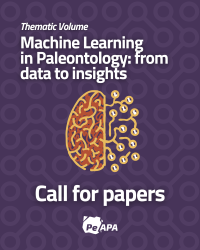STATISTICAL ANALYSIS OF PALYNOLOGICAL ASSEMBLAGES FROM THE APTIAN-ALBIAN OF THE ARARIPE BASIN, NORTHEAST BRAZIL: A CASE STUDY OF PALEOENVIRONMENTAL SIGNIFICANCE OF EARLY CRETACEOUS TERRESTRIAL PALYNOMORPHS
Abstract
Statistical treatment of palynological data from Rio da Batateira and Santana formations (Aptian-Albian) of the Araripe Basin provides mathematical support to paleoclimatic interpretations. In addition to Classopollis and ephedroid pollen, widely accepted as aridity indicators, other typical xerophytic elements include Afropollis spp., Spheripollenites subgranulatus Couper, Monosulcites s.l., Brenneripollis peroreticulatus (Brenner), and bisaccate pollen. The correlation between ephedroid pollen and perisporium-bearing spores is surprising, since pteridophytic spores normally tend to be incompatible with xerophytic elements. This fact may be explained by the habitat of this pteridophytic flora which occupied humid river-side lands under general dry climatic conditions. Another unexpected correlation is that of bisaccate pollen with Classopollis and ephedroid pollen. In the Aptian-Albian of the Araripe Basin, as elsewhere in the West African-South American Microfloristic Province, bisaccates are never dominant, but occasional peaks in their relative abundance coincide with relative peaks of other arid climate palynomorphs. This fact is explained by their wind-born transportation. They may concentrate in basins situated in dry scenarios with low local palynomorph production. Interesting interpretations may be established from the correlation observed in angiospermoid pollen. While primitive monoapertura te pollen grains (Afropollis and Brenneripollis) are closely related to arid climates, tricolpate pollen grains show some divergence in their correlations. The correlation of tricolpates with both ephedroid and trilete spores is significant, but its correlation with Classopollis is weak. This may indicate the occupation of a wide range of habitats by the primitive angiosperm flora.
KEY WORDS. Brazil. Araripe Basin. Cretaceous. Palynology. Statistical analysis.
Downloads
Published
Issue
Section
License
Authors retain copyright and grant the journal right of first publication with the work simultaneously licensed under a Atribución/Reconocimiento 4.0 Internacional that allows others to share the work with an acknowledgement of the work's authorship and initial publication in this journal.
















